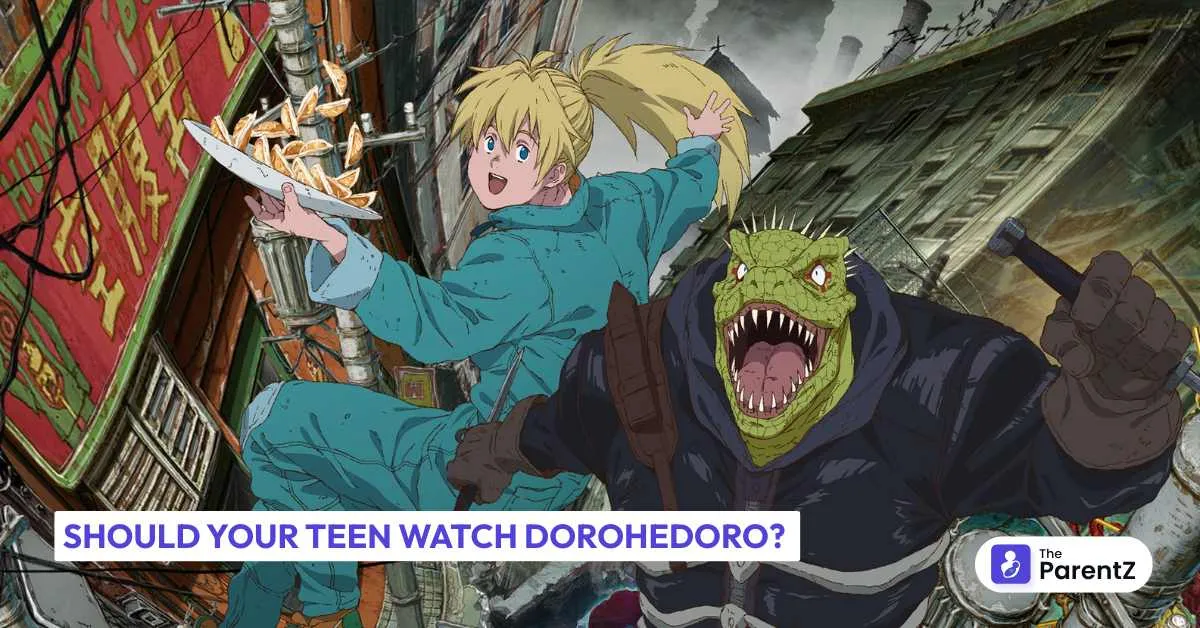Introduction
Dorohedoro doesn’t try to make sense—it dares you to sit in the middle of nonsense and find meaning. It’s messy, bizarre, grotesque… and strangely heartfelt.
This ultra-violent, dark-fantasy anime drops viewers into a lawless world of magic users, human experimentation, and talking lizards. But buried inside the blood, curses, and absurd humor is a surprisingly human story about memory, friendship, identity, and forgiveness.
For teens, especially those drawn to edgy or surreal narratives, Dorohedoro can be fascinating. But it requires serious emotional maturity to absorb what it’s truly about—because this isn’t just chaotic violence. It’s trauma wrapped in a neon butcher’s apron.
Overview
The story centers on Caiman, a man cursed with a lizard head and no memory of who he is. Living in the bleak, polluted “Hole,” he hunts magic users responsible for his transformation, biting their heads and letting the strange man living in his throat interrogate them.
Yes, it’s that weird.
Caiman is joined by Nikaido, a strong-willed woman with secrets of her own. Together, they clash with En, a powerful magic-user with a mushroom obsession, and his bizarre inner circle.
From severed limbs to casual murder to dinner parties between enemies, Dorohedoro exists in a world where the surreal feels normal, and violence is part of everyday life. But somehow, there’s warmth beneath the madness.
Themes
1. Identity and Memory
Caiman’s central journey is about figuring out who he is—literally. But that mystery is layered with metaphor: What defines a person? Their memories? Their choices? Their scars?
As he uncovers pieces of his past, he begins to question his morality, his vengeance, and even his sense of self. For teens who are forming their own identities, this story of fragmented memory and emotional rebirth might resonate more deeply than expected.
2. Found Family and Loyalty
Despite its gore and absurdity, Dorohedoro is shockingly tender. The bond between Caiman and Nikaido is one of the most grounded friendships in anime—based on trust, care, and shared survival, not romance or trope.
Even En’s crew of villains treat each other with respect and loyalty, blurring the line between "good guys" and "bad guys." This nuance offers a refreshing take on relationships, where chosen family often matters more than blood.
3. Violence and Emotional Detachment
The show is violent. Heads are cut off. People are burned alive. Limbs regenerate and are lost again. But what makes it unique is how casually this violence is treated by the characters.
This detachment is both a stylistic choice and a reflection of the brutal world they live in. For some teens, this may desensitize emotional stakes. For others, it may spark important questions about trauma, normalization of cruelty, and what it means to keep your humanity in an inhumane world.
Age Preference
Recommended for: 17+
Between the graphic violence, dark humor, gore, body horror, and mature themes (including cannibalism and moral ambiguity), this series is inappropriate for younger teens—even those used to intense action anime.
Who Should Not Watch
- Viewers under 17 or those sensitive to gore and disturbing imagery
- Teens currently struggling with trauma, PTSD, or emotional detachment
- Anyone expecting a clear plot or traditional moral compass
- Parents seeking uplifting, redemptive narratives or conventional justice arcs
This series celebrates chaos. And while it has emotional depth, it often hides it beneath splattered blood and mushroom-induced hallucinations.
Lessons From It
Dorohedoro reminds us that morality isn’t always black and white. Good people do bad things. Bad people show kindness. And sometimes, the line between monster and man is blurry on purpose.
It also celebrates resilience—not in the form of revenge or dominance, but in the quiet decision to keep going. To protect a friend. To cook dinner. To laugh, even when everything’s on fire.
Its core message? Even in a world built on decay and death, identity and connection still matter. Sometimes, surviving with your soul intact is the greatest magic of all.
Conclusion
Dorohedoro is a violent, vulgar, and visually chaotic ride—but it’s not empty. Under the blood and absurdity, it holds a surprising heart. For the right teen—one emotionally mature enough to handle moral complexity and grotesque humor—it can be a wildly imaginative and oddly moving experience.
But context is everything. Don’t let the jokes and gore distract from what the show is asking: What does it take to stay human in an inhuman world?
If your teen is watching—or wants to—watch with them. Then talk. Not about the weirdest scene. But about the gentlest one. That’s where Dorohedoro reveals who it really is.








Be the first one to comment on this story.